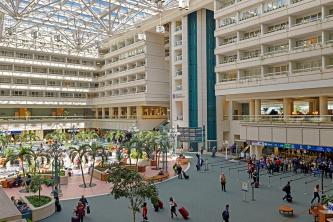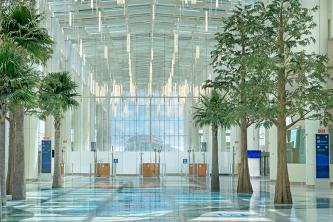Orlando International (MCO) Evolves As A Multimodal Transportation Hub

Orlando International Airport (MCO) is the global gateway to the most visited destination in the United States. Known worldwide as a top leisure and convention destination, with the third-largest convention center in U.S. and more than 130,000 hotel rooms, Orlando welcomed 74 million visitors in 2022, just 2% below its all-time record from 2019.
It surprises many to discover that Orlando is also renowned as a center for high-tech industry, which has been building in Orlando since the 1960’s. Orlando is now the World’s Capital for Modeling, Simulation and Training (MS&T) and is globally recognized in the aerospace and defense sector. Other top sectors include film & digital media, photonics and information technology. More recently, bio-med has developed into a major industry cluster with the addition of “Medical City” in Lake Nona, which borders the airport. This 650-acre health and life sciences park features a cluster of biomedical organizations and institutions that centralizes sophisticated medical treatment, research, and education in Central Florida. It therefore comes as no surprise that Metro Orlando is consistently listed among the hottest markets in the nation for entrepreneurs, business and job growth.
This blend of leisure, conference, business and VFR traffic, propelled by consistently above industry average growth rates has driven MCO to become the busiest airport in Florida, with over 54.5 million annual passengers through June 2023. This volume and mix of traffic is very attractive to airlines, with more than 35 passenger airlines currently serving the airport with almost 1,000 flights per day to over 150 destinations including more domestic destinations than any other Florida airport.
Orlando International Airport is in the center of the state, with over 62% of Florida’s population (over 13 million people) within a 2-hour drive, creating the largest airport catchment area in the Florida. To better serve the needs of the diverse Central Florida community and the demands of projected passenger growth, MCO’s infrastructure has evolved in recent years with significant new additions to increase capacity, provide additional services and enhance the customer experience.

Driven by the increase in Orlando-originating traffic, the airport opened a new parking facility (Garage “C”) in November 2017, close to the site designated for future terminal expansion. This coincided with the opening of the Train Station, adjacent to the parking garage, which incorporates rail as a new mode of transportation into the long-term plan to “advance Orlando and the region as the premier intermodal transportation gateway for global commerce.” The Train Station is the central hub to this design concept, connecting directly to Parking Garage C, connecting to Terminals A and B via the Train Link people mover, and as of September 2023, connecting to downtown locations in South Florida via Brightline. Brightline is the only privately owned and operated intercity railroad in the United States, and Orlando International will become the only U.S. airport offering direct access to high-speed intercity rail.
In addition to adding rail to its multimodal offerings of road, air, and sea (via a 40-minute drive on a straight, 4-lane highway), the growth of passenger traffic at the airport also drove construction of its third terminal. Terminal C opened in September 2022 and became home to JetBlue, Aer Lingus, Azul, British Airways, Caribbean, Emirates, GOL, Icelandair, Lufthansa and Norse Atlantic. The new terminal features 15 multiple aircraft ramp system (MARS) gates, enabling them to accommodate up to 20 aircraft simultaneously. It also provides an exceptional passenger experience including a combination of concessions featuring local flavors and national brands, engaging shopping experiences, and large format experiential media displays. The lounge, managed by one of the leading global independent lounge operators, features a dedicated area for families, a restaurant and bar, and quiet spaces for business travelers.
The baggage system in Terminal C also provides traveler benefits that are new to the airport, including storage for early bag drop-off, and as each bag is placed into a tote equipped with Radio Frequency Identification Technology (RFID), the baggage system efficiently tracks each bag throughout the entire system.

Passengers on international flights into Terminal C will also benefit from enhancements to the arrivals experience. After exiting the aircraft, passengers will enter the terminal on the top floor, surrounded by space, natural lighting and expansive views across the airfield. Passengers arriving at this U.S. Customs and Border Protection “Bags First” facility will then claim their baggage before proceeding to passport control, where biometric technology will confirm identity and documentation, improving efficiency, safety and convenience.
Terminal C is celebrating its first anniversary and has had a busy year. More airlines have moved in (including Lynx Air, Red Way and Sunwing) and the terminal is on track to process 7 million annual passengers in its first full year of operation. It is also undergoing expansion to add four additional gates that will be operational by 2025.

